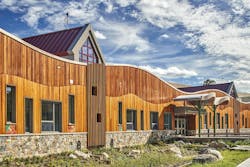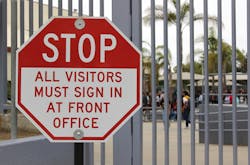Two weeks into the new year, deadly gun violence in schools hit the headlines again. A 17-year-old student at Antioch High School in Nashville opened fire in the cafeteria and killed a 16-year-old female student before taking his own life with a self-inflicted gunshot. Those deaths came about a month after a 15-year-old girl fatally shot a 14-year-classmate and a teacher before shooting herself to death at Abundant Life Christian School in Madison, Wisconsin. The sad fact is that shootings at schools and universities are not the shock to the system that they once were.
It would an unfair exaggeration to say the school shootings had become commonplace, but in the quarter-century since an attack at Columbine High School in Colorado left a teacher and 14 students (including the two shooters) dead, the periodic recurrence of deadly school violence and the attention the most horrific episodes attract may make it seem that the nation’s 50 million elementary and secondary students and the 19 million students enrolled in higher education are in peril each time they head off to attend classes.
The reality is that compared with other aspects of society, schools are relatively safe. But communities want educators and administrators to make every effort to bolster school security, create climates conducive to learning and minimize the likelihood that their schools will be victimized by violence.
In the aftermath of tragedies such as the mass shooting deaths at schools in Newtown, Connecticut, and Uvalde, Texas, panels and commissions have provided reams of recommendations for how schools can be made safer. Schools and universities can absorb the lessons learned from the tragic shootings others have experienced to make their campuses more secure.
Designed for improved safety
In the aftermath of a violent episode, schools may make operational changes or adopt new security solutions for a campus. But in some extreme cases, the enormity of an event proves to be too traumatic for students and staff to resume classes in a building.
After 20 young children and six adult staff members were shot to death in 2012 at Sandy Hook Elementary in Newtown, Connecticut, the school was torn down and replaced by a building that incorporated enhanced security features. In Uvalde, Texas, a new elementary is being built to replace Robb Elementary, where 19 children and two adults were killed in 2022 after a shooter entered the school.
The new Sandy Hook opened in 2016 after a report from the state’s School Safety Infrastructure Council provided recommendations for improving security on campuses
The Council identified four major goals for improving school security:
- Deterrence – to prevent unwanted visitors from gaining access to school grounds or buildings, and avert the impact of natural threats that could result in potential harm to students, staff and property.
- Detection – to quickly locate, identify and contain the movement of an unwanted party who has gained unauthorized entry to a school.
- Delay – to impede, isolate and forestall the movement of an unwanted party within a school building; to prevent access to classroom areas and common gathering points so that there is adequate time for a public safety response.
- Response – to ensure that coordinated, interactive and reliable communication systems and procedures are in place to facilitate an immediate and effective response from public safety and medical agencies.
Based on those goals, the report list dozens of security recommendations for schools to adopt with regard to access control, surveillance, parking and vehicular routes, recreation areas, communications, the building exterior, the main entrance, doors, windows, classrooms, assembly areas, roofs, shared space and utilities.
"[P]rotective school design techniques, better planning and uniform standards can make school grounds and school buildings safer places in which to conduct educational activities," the Council's report said.
In Uvalde, Robb Elementary is to be demolished and replaced by a new campus, Legacy Elementary, which is scheduled to open later in 2025. Among the security enhancements planned for the campus:
The school will have a single point of entry and exit for visitors. They will have to enter through a secure vestibule and must show credentials to enter the space. The vestibule also will have restrooms and a meeting room to limit the need for visitors to gain access to the school proper. Nine-foot-tall privacy gates will surround student and staff entrances. Outdoor play areas will be enclosed with security fencing. Security cameras will be installed.
In addition, the design of Legacy Elementary will incorporate trauma-informed strategies intended to lower the stress levels of students and staff. Those include improving accessibility by removing environmental barriers; adding biophilic elements to connect with nature and living beings; and an emphasis on inclusion and equal access, which enhances students' comfort and belonging.
Broader strategies
School shootings, especially those that result in multiple fatalities, always will get the lion’s share of public attention. But educators and administrators also should be vigilant about recognizing and working to prevent other types of violence in schools.
A report from the Educator’s School Safety Network, Violent Threats and Incidents in Schools: An Analysis of the 2023-24 School Year, notes that the majority of violent incidents in schools are not gun-related.
Compiling data based on media reports, the network found that in 2023-24, a shooting in a school or on school grounds accounted for 9.3% of violent incidents; outside violence spilling into a school accounted for 10.1% of incidents a, a gun found on campus accounted for 15.9% of incidents, and false reports of an active shooter accounted for 29.5% of incidents.
“The first critical step for improvement is to shift the thinking about school safety from an occasional concern or an active shooter event to an everyday all-hazards approach for educators,” the network’s report urges.
The network’s recommendations:
- Training, resources, and emergency planning for schools needs to focus on an all-hazards approach to school safety.
“The erroneous belief that active shooter events are the most significant hazard schools face leaves educators vulnerable and unprepared for the more likely crisis events they will encounter,” the network says. “In many cases, the only training educators receive is geared toward a school shooting, even though it is one of the least likely crisis events.”
Schools should pay greater attention to operational procedures such as supervision, accounting for students, relationship-building, access control and visitor screening, the network recommends. Staff members should be provided with adequate training not only in school lockdowns, but also in emergency response procedures, plans for evacuation, parent reunification, and crisis communications.
- School safety practices alone are not effective in reducing school violence; prevention strategies should play a greater role.
“Preventing violence, not just responding to it, must become a priority,” the network says. It advocates strategies aimed at improving school climate and culture, offering appropriate supports and interventions to those at risk for violence, and putting more effective supervision in place.
“Attention must be paid to the consequences of creating a prison-like, surveillance-based environment in schools, where students are viewed as potential perpetrators and educators are forced into security and policing roles,” the network says.
- Schools should recognize and work to lessen the effect that false reports of bomb threats or other violence can have on student safety and the school climate.
“The task of assessing the validity of these threats and false reports...puts educators and emergency responders in a difficult position, often with little training or support in what to do, the network says. “Even worse, the frequency and scope of swatting and bomb threats consumes significant financial and personnel resources and almost always results in the loss of instructional time, negatively impacting academic achievement.”
Improvements seen
Some of the conditions that can create an unpleasant environment in schools have improved in thie last decade.
The federal government’s Report on Indicators of School Crime and Safety: 2023 cites several areas where elementary and secondary campuses appear to be safer for students and teachers.
- Between 2012 and 2022, the nonfatal criminal victimization rate (including theft and violent victimization) for students 12 to 18 years old decreased from 52 victimizations per 1,000 students to 22 per 1,000.
- The percentage of students ages 12 to 18 who reported being bullied during school dropped from 28% in 2010-11 to 19% in 2021–22.
- The percentage of public school teachers reported being threatened with injury by a student or being physically attacked by a student fell from 10% in 2011–12 to 6% in 2021-22).
- 6% of students ages 12 to 18 reported gang presence in their schools in 2021–22 compared with 18% in 2010–11.
About the Author
Mike Kennedy
Senior Editor
Mike Kennedy has been writing about education for American School & University since 1999. He also has reported on schools and other topics for The Chicago Tribune, The Kansas City Star, The Kansas City Times and City News Bureau of Chicago. He is a graduate of Michigan State University.



